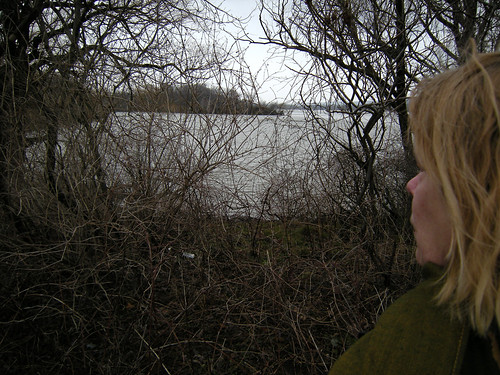
Hamilton’s art community has a vibrant history of engaging with public installations. When dislocated from the antiseptic confines of the art gallery, art becomes more fluid and more of a subjective and discursive enterprise. The Urban Moorings Project is a group installation on the wetlands of Cootes Paradise. Artists Susan Detwiler, Noel Harding and David Acheson, Steve Mazza, and Tor Lukasik-Foss have created floating sculptures and gardens which are intended to question the nature of human industry and ecological preservation. Curator Nora Hutchinson describes the project as “travelling canvas, one that is ever changing…sun on calm waters extends and mirrors perfectly the sculptures and their reflections on the bay. Morning fog, dusk, and the terrible beauty of Hamilton’s factory plumes of smoke and fire play a part in this ineffable landscape. Culled into the visual frame of floating homes, there is the call of birds, the hush of wings and the sound of water lapping…”
Asked why Cootes Paradise was chosen, Hutchinson responds that when one is at Cootes, a “quiet beauty is experienced”. Hutchinson researched the history of the area, and decided that the artists would dialogue with a historical community of floating homes that was situated on the shores of Cootes prior to the 1950s. “Dubbed ‘Shacktown’ by the locals, the houses were built by workers so that they could live near their industrial workplaces. Their homes were mostly made with materials at hand – tin, tar, wood, brick. They built their homes on the water in order to easily respond to the pressures of urban development. When forced to move, they simply floated their homes upstream to a new location on the Bay. The second dialogue between the artworks and the location of Cootes Paradise, concerns the restoration efforts of the RBG to clean up the water and landscape of Cootes and to re-introduce native plants and fish. Responding to both historical and ecological issues, the artists' sculptures will be made mostly with pre -purposed materials and with a focus of using symbols for cleaning the water, to creating islands, and to address the post-industrial landscape.”
For the site, Tor Lukasik-Foss has created what he terms Viking Soliloquy Chair. Made from re-claimed oak, cedar, and mixed media, the chair transforms a sinking Viking ship into a piece of floating stage furniture useful for all manners of monologues and songs. Susan Detwiler will install a shelter frame in order to grow edible plants from household cleaning tools such as brooms, swiffers, and mops. In their piece entitled Romance Park for Endangered Turtles, Noel Harding and David Acheson have created a series of turtle basking platforms. Along with Water aeration and wetland plantings, the piece intends a theatrical stage upon which the terms of environmental engagement are to be interrogated.
For Steve Mazza, industry in Hamilton is examined as a fossil of the past which considers “what it means to live in an industrial city, in an industrial province, in a country that doesn’t seem to want to be industrial anymore”. His sculptural piece playfully engages with the notion that industrial endeavour is outdated and remains extent largely as an urban-scale museum somewhat invisible to the city’s hopes for future development and the dreams of individual citizens for a ‘perfect community’. Mazza’s industry is hermetically sealed in a greenhouse structure which suggests the need to remain conscious of the city’s past, which informs the present in both architectural and environmental terms.
Irene Loughlin of Hamilton Artists Inc expects that the public will respond in a positive manner to the installations. “This exhibition of sculptural art works is non-traditional in that it takes place outside of the gallery. A person might suddenly come across the artworks while strolling down a pathway in a walk at Princess Point. The strategy of placing art in a public place highlights the fact that art is part of our daily life and that art is a valuable part of our daily experience. The artworks respond to the elements, are reflected in the waters of Princess Point, and are affected by the wind... The installation becomes alive, pointing to the rich history of this historic site.”
Urban Moorings opens Saturday, June 21 at 1 pm at Princess Point in Cootes Paradise and will remain in place until August 5. An artist panel discussion follows at 6 pm June 26 at the McMaster Museum of Art. A film about endangered wetlands in Finn Slough, British Columbia will then be screened at Hamilton Artists Inc July 11 at 7 pm. Finally, a panel discussion between the artists involved in the project and the RGB will take place at the RGB auditorium on July 13 at 2 pm.
Hamilton Artists Inc presents URBAN MOORINGS
June 21 - August 5
Coots Paradise

No comments:
Post a Comment